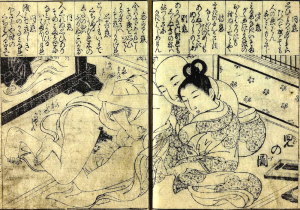Chigo: Difference between revisions
Modified the introduction of the article |
Made a few changes to the wikicode |
||
| (17 intermediate revisions by the same user not shown) | |||
| Line 1: | Line 1: | ||
{{draft}} | {{draft}} | ||
[[File:Tsukioka Settei - Buddhist monk having anal intercourse with boy.png|thumb|right|Buddhist monk having [[anal intercourse]] with boy. | [[File:Tsukioka Settei - Buddhist monk having anal intercourse with boy while masturbating him. Double-page Japanese woodblock-printed illustration from Onna Teikin Gejo Bunko, circa 1768.png|thumb|right|Buddhist monk having [[anal intercourse]] with boy while [[Masturbation|masturbating]] him. Double-page Japanese woodblock-printed illustration by Tsukioka Settei, from ''Womanly Virtue and a Library on the Private Parts'' (女貞訓下所文庫 ''Onna Teikin Gejo Bunko'', circa 1768).]] | ||
In premodern [[Japan]], a <i>chigo</i> (稚児) was a [[boy]] novice of about seven to fourteen years of age training | In premodern [[Japan]], a <i>chigo</i> (稚児) was a [[boy]] novice of about seven to fourteen years of age in training at a [[Buddhist]] monastery. | ||
This word can have a second meaning derived from the first: it denotes a young boy loved by a [[monk]] in the context of a relationship that was both [[initiatory]], emotional and | This word can have a second meaning derived from the first: it denotes a young boy loved by a [[monk]] in the context of a relationship that was both [[initiatory]], emotional and frequently sexual. | ||
== Vocabulary == | == Vocabulary == | ||
The word ''chigo''稚児(approximate pronunciation: /tʃi.go/) consists of two characters: | The word ''chigo'' 稚児 (approximate pronunciation: /tʃi.go/) consists of two characters: | ||
* 稚 ''chi'' = child | * 稚 ''chi'' = child | ||
* 児 ''ko'' = child, boy | * 児 ''ko'' = child, boy | ||
== Literature == | == Literature == | ||
A particular genre is [[chigo monogatari]], which | A particular literary genre is ''[[chigo monogatari]]'', which consists in love stories between monks and novices. For example in ''Long Story for an Autumn Night'' (秋夜長物語 ''Aki no yo nagamonogatari''), the anonymous author recounts the linking Keikai and young Umewaka. | ||
== Saying == | == Saying == | ||
| Line 23: | Line 23: | ||
''Ichi chigo nor Sanno.'' | ''Ichi chigo nor Sanno.'' | ||
First the ''chigo'' then the god of the mountain. | ''First the'' chigo, ''then the god of the mountain.'' | ||
* Tôzô Suzuki, ''Koji Kitowaza Jiten,'' Tokyodo Shuppan, 1956, p. 59 (trans. BoyWiki) | * Tôzô Suzuki, ''Koji Kitowaza Jiten,'' Tokyodo Shuppan, 1956, p. 59 (trans. BoyWiki) | ||
Latest revision as of 10:35, 18 August 2021
Note this page is still under construction. |

In premodern Japan, a chigo (稚児) was a boy novice of about seven to fourteen years of age in training at a Buddhist monastery.
This word can have a second meaning derived from the first: it denotes a young boy loved by a monk in the context of a relationship that was both initiatory, emotional and frequently sexual.
Vocabulary
The word chigo 稚児 (approximate pronunciation: /tʃi.go/) consists of two characters:
- 稚 chi = child
- 児 ko = child, boy
Literature
A particular literary genre is chigo monogatari, which consists in love stories between monks and novices. For example in Long Story for an Autumn Night (秋夜長物語 Aki no yo nagamonogatari), the anonymous author recounts the linking Keikai and young Umewaka.
Saying
A popular saying clearly expressed the priority given by the monks to their young companions:
Ichi chigo nor Sanno.
First the chigo, then the god of the mountain.
- Tôzô Suzuki, Koji Kitowaza Jiten, Tokyodo Shuppan, 1956, p. 59 (trans. BoyWiki)
See as well
Related articles
Notes and references
- ↑ Japanese transcript and English translation by Margaret H. Childs in " Chigo Monogatari, love stories or Buddhist sermons? "p. 1. [[Downloadable article)]]
